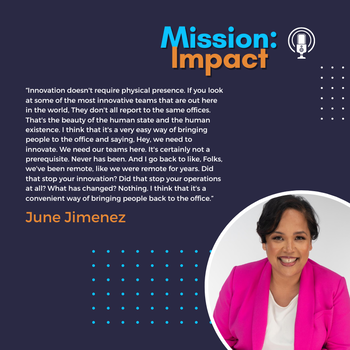Mission: Impact podcast & blog
Build a better world without becoming a martyr to your nonprofit cause
Listen on:
 In episode 87 of Mission: Impact, Carol Hamilton and June Jimenez discuss:
00:20:30: Decision-making driven by prior investments in physical office spaces
00:21:00 The myth of physical presence as a prerequisite for innovation and organizational culture 00:23:00:** Culture exists in both remote and co-located setups 00:24:30:** Younger employees challenges with integrating with organizational cultures 00:26:00:** Particular challenges for newer generations in navigating office culture remotely 00:28:30:** What leaders need to think about in terms of informal nature of information exchange in physical offices vs. remote settings. 00:29:30:** Strategies for helping new staff integrate, 00:33:30:** Training and development for managers successful adaptation to remote work Guest Bio: June Jimenez is an organizational development consultant to mission-focused organizations. June's work focuses on the people, systems, processes and technology needed to help organizations deliver their missions while experiencing tremendous change. June brings over 20 years of professional experience to each engagement gained through her work across the nonprofit, government and private sectors. June is a mother to a 10 year old rabble rouser, partner to a retired police and military professional and passionate about social justice. June received her Bachelor’s degree from Cornell University and received her Executive MBA from the University of North Carolina at Chapel Hill. Important Links and Resources: June Jimenez: https://www.linkedin.com/in/jimenezjune/ Register for the Nonprofit Leadership Roundtable (12/14/23 at 1:00pm eastern): https://www.eventbrite.com/e/760734085127?aff=oddtdtcreator Click "Read More" for interview transcript. When you are used to meeting in person, it is easy to see the disadvantages of online meetings. You are missing out on a lot of body language and other non-verbal cues. Yet the sudden shift to everything online since March 2020 has demonstrated many of the advantages of online meetings. No commute
Saves moneyNot only do your participants save time and money on travel, your organization saves money. You do not need to rent a meeting space and serve the group food. You will need to pay for an online meeting hosting service such as Zoom or Adobe Connect as well as perhaps an online collaboration tool such as Mural or Miro. These costs, however, will be substantially less than what you would have paid for in food, AV rental, printing and other costs of the meeting. It also makes it easier for your nonprofit's volunteers participate. They do not have to donate travel time in addition to the actual time in the meeting or event. Using technology to your advantageThere are lots of ways that the technology itself can help you run an effective meeting.
Want to learn more about how to effectively facilitate online meetings? Join my four-week group coaching program. A new cohort starts in September. Building rapport with people online is one of the things nonprofit leaders often mention as a challenge in online meetings. Yet with some intention it is possible. Connection before content Photo by Anna Shvets from Pexels Photo by Anna Shvets from Pexels A good practice (whether in person or online) is to be sure to take some time at the beginning of the meeting to connect on a personal level before you jump into the meeting agenda. This could include a check in question such as an ice-breaker. Some people cringe when you mention icebreaker. Yet the question does not have to be “what Harry Potter character are you?” or [fill in the blank with a question you got asked at beginning of a meeting that had nothing to do with the issues at hand]. It can be work-related. Especially with groups who do not know each other making the question relatively safe is often a good place to start. What is your super-power? What is the latest app you discovered and love? What are you hoping we achieve today? If the group is large and you are afraid intro’s and icebreakers will take up a chunk of the meeting time, split people into smaller groups (2-4) and have them introduce themselves in their small group. Yet the question does not have to be “what Harry Potter character are you?” or [fill in the blank with a question you got asked at beginning of a meeting that had nothing to do with the issues at hand]. It can be work-related. Creating NormsIf the group is going to be working together for a while, help them have a conversation about how they want to work together. What helps them work effectively in a group? What might get in the way working together online and remotely? How might they address those challenges? It may take a few rounds of brainstorming and refinement to come to a set of agreements that work for everyone. Yet having this list of agreements will help if the group runs into challenges. PauseRapport and trust will be lost if a person in the group does not feel like their voice is being heard. They may feel you are rushing through items without sufficient time for discussion. A good practice as a meeting leader is to pose a question or discussion topic and then take a drink of water. It takes a little bit longer on line for people to jump into the conversation. They may hesitate wondering whether someone else is going to talk and not wanting to interrupt anyone. Taking that drink will prevent you from continuing to talk and gives your meeting participants time to gather their thoughts and respond. Checking inDo you really know whether everyone is with you and in agreement? Check in more frequently with the group to make sure:
Don’t assume silence means agreement. This blog post goes into more detail on checking in. Want to learn more about facilitating effective online meetings? Sign up for my four-week group coaching program on Effective Online Facilitation.  Photo by Andrea Piacquadio from Pexels Photo by Andrea Piacquadio from Pexels One of the things that facilitators worry a lot when shifting from facilitating in the room to facilitating on line is not being able to “read the room.” But what if they've been “reading the room” inaccurately? Sometimes people's body language is super obvious yet most of the time in the nonprofit workplace it tends to be more subtle. Facilitators may have been engaging in mind reading when they think they are reading the “vibe” in the room yet they really did not know what the participants in the group were thinking and feeling. "Reading the room" onlineWhat if facilitating online actually meant you paid more attention to “reading the room”? How might you track it?
One of the tips for facilitating online is to check in more frequently with the group that you're working with. Here are four ways to think about monitoring progress. Getting connectedThe first is to make sure that you're establishing connections and setting expectations at the beginning of your meeting. What is some pre work that people could engage in so that they could do some thinking beforehand? How might you spend a few minutes to help people get to know each other a little better? How might you use a tool like OARR - Outcomes agenda roles and rules --to orient people as you start out? Signaling your turnsThe second category is making sure that you're helping people track your progress in your process. You might use polling to assess your engagement, understanding and effectiveness. You might do a quick “POP” check in on purpose, outcomes and process. You need to ”signal your turns” so that you are clear about when you're moving from one agenda item to another. Take a pause to make sure everyone is with you especially if you are moving from using one technology tool to another. You can also use visual tools to help you track progress Are we in agreement?A third category is checking for understanding or checking for consensus. You'll likely want to do this more often in an online meeting than you would in person. This means that you need to allow more time to achieve the outcomes then you might have normally budgeted in an in-person meeting. It's slowing down and questioning your assumptions. Taking the time to make your thought process more explicit. Some tools that you might use included a quick check in what's called a “fist to 5.” You ask people to make a show of hands/fingers where they are. You designate what the fist means and what 5 fingers mean. Let's say 5 fingers means high agreement or understanding. This can be used in lots different ways. Another is the gradients of agreement which helps breakdown what consensus looks like. I've described using this tool another post. Carol, how are you doing?The fourth way to approach monitoring group progress online is to check in with individuals. In some ways online platforms makes this easier than in person. When I am in front of a large room of people it's unlikely that I'm going to be able to see all their name tags. But on a Zoom call I can usually see at least a first name or some kind of identifier to ask people individually how they're doing. You will want to have some discussion around group norms about whether it’s ok to ask people who haven't talked much to chime in and share. This may depend on the where your group is in terms of its evolution and development. Getting helpYou could also share the job of paying attention to and monitor the group. You might have a co-host who's monitoring reactions and gallery view while you're focused on facilitating the meeting. You will want to come to agreement beforehand that they can interrupt you and ask questions of the group. Most important (this certainly is true in an in person as well but even more so online), do not assume that silence means consent. Or assume it means discontent.
Need to learn more about how to work with groups effectively online? Check out my program. If you are like a lot of the world, you suddenly having to lead your nonprofit team and your meetings online. What do you need to do differently than your regular practices in the room? Distraction, distraction, distraction Photo by Andrea Piacquadio from Pexels Photo by Andrea Piacquadio from Pexels It is hard enough to keep everyone on track when you are together in a room. Then add technology and distance. Your phone and email chirping in the background. Getting on Zoom and wondering whether your co-workers have pants on. Your kids or pets making a ruckus in the next room. Online meetings have to fight for people’s attention even more than in person. Ask for their focusWhen you meet online, everything else on the person’s computer or device is there to distract them. A simple step you can take is to ask them to close their extra tabs, email, notifications, etc. for the duration of the meeting. Remember to take breaks. Take a moment for everyone to get out of their chair and stretch. Match your tech tools with your participantsYou may be excited about trying out the online brainstorming tool you just heard about but make sure that what you choose matches the skills of your participants. You want people focused on your conversation not on struggling to make the tool work. So for some groups Zoom and a google doc will be a perfect match. For others Zoom or another video conferencing tool plus an online brainstorming tool like Miro or Mural will work great. Educate your participantsYou can try and avoid spending the first 10 minutes of the meeting getting everyone acquainted with the technology systems by creating a video or two that provides a quick overview. Loom is good for this and very easy to use. You might also give the group a small assignment that gets them into the tool you will use for note taking. Something as simple as asking them to open a google doc and write their name at the top of the document. Or if you are using a more sophisticated tool such as Mural – have them do a check in process – this kick starts your check in at the beginning of the meeting and has them play with the tool with no time pressure.
Need to learn more? Consider enrolling in my four-week group coaching program, Effective Online Facilitation. For more tips |
Archives
April 2024

Grace Social Sector Consulting, LLC, owns the copyright in and to all content in and transcripts of the Mission: Impact podcast, as well as the Mission: Impact blog with all rights reserved, including right of publicity.
|
Telephone301-857-9335
|
info[at]gracesocialsector.com
|
Grace Social Sector Consulting, LLC, owns the copyright in and to all content in, including transcripts and audio of the Mission: Impact podcast and all content on this website, with all rights reserved, including right of publicity.
|